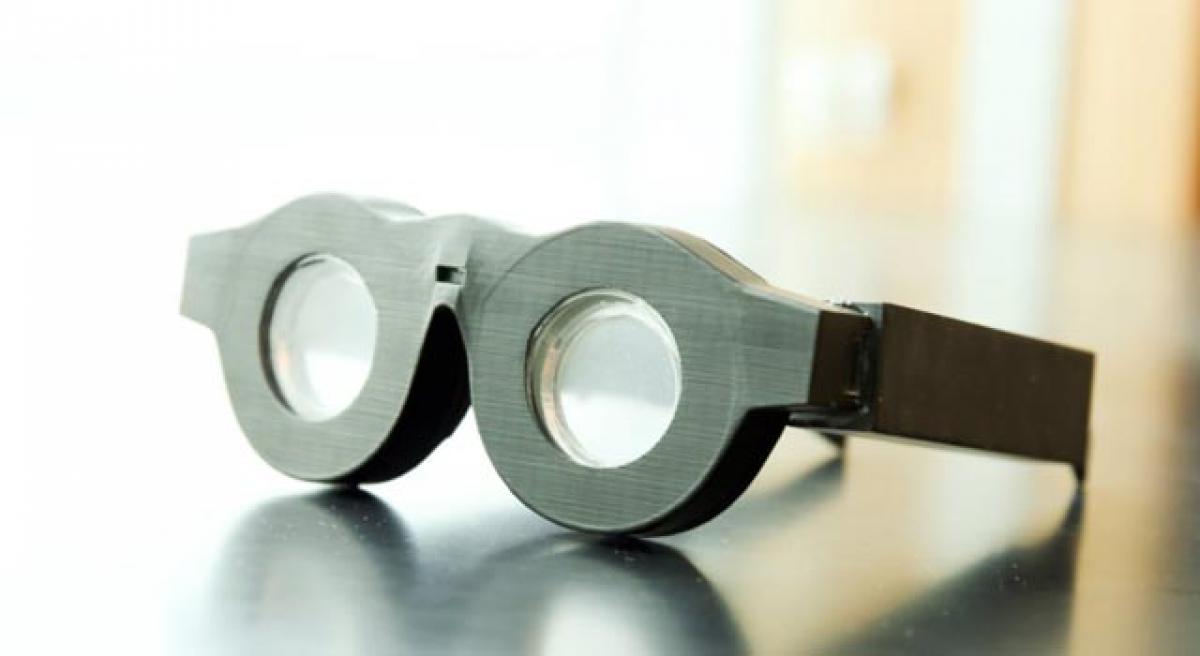Live
- Gold rates in Visakhapatnam today surges check the rates on 10 January, 2025
- Gold rates in Hyderabad today surges check the rates on 10 January, 2025
- State cabinet meeting in MM Hills on February 15
- Gold rates in Vijayawada today surges check the rates on 10 January, 2025
- Man held for Rs 10.32 lakh cyber fraud
- Several VIPs Flock to Tirumala amid Vaikuntha Ekadashi
- Rising number of mortalities of infants in Yadagiri causes concern
- Jeans park to be set up in Ballari: 154 acres acquired, says MB Patil
- Veena concert captivates audience
- Nadendla lauds RTGS, confident of tech potential to change governance
Just In
Flexible liquid lenses that adjust to need of the wearer


The central technology of the glasses created by the research team are lenses made of glycerin, a clear thick liquid sandwiched between flexible membranes.
Engineers funded by the National Institute of Biomedical Imaging and Bioengineering (NIBIB) have developed glasses with liquid-based lenses that “flex” to refocus on whatever the wearer is viewing. The adjustable “smart glasses” were developed by a University of Utah team led by electrical and computer engineering professor Carlos H. Mastrangelo, Ph.D., and his doctoral student Nazmul Hasan. The work is reported in the January 17 issue of Optics Express.
“The glasses incorporate an impressive array of electrical, mechanical, optical, sensor, and computer technologies with the goal of developing a one-size-fits-all approach to vision correction,” said Andrew Weitz, Ph.D., NIBIB program director, whose expertise includes bioelectronic vision technologies.
The glasses are designed to mimic the behavior of the eye’s natural lens—flexing to focus on wherever an individual is looking: near, far or in-between. Unfortunately for many of us, as we age our lenses become stiffer and lose the ability to bend enough to focus at different distances.
Standard glasses compensate for the bend our ageing eyes can no longer achieve to focus. This becomes more complicated if we are unable to focus at multiple distances, which necessitates glasses with multiple lenses for different distances, such as bifocals, trifocals or progressive lenses, which must be regularly replaced as our eyesight changes.
The central technology of the glasses created by the research team are lenses made of glycerin, a clear thick liquid sandwiched between flexible membranes. The lenses are mounted into frames that have an electromechanical system that causes the membranes to bend to adjust their focus. The ability of the lens to flex and bend allows the single lens to act like multiple lenses.
The glasses are designed to work for most people at a wide range of distances due to a sophisticated computer algorithm that works with two critical variables. One is the eyeglass prescription that the user enters into the system using an attached mobile app. The other is where the user is looking—specifically how far away. This information is provided by a sensor mounted in the bridge of the glasses that uses pulses of infrared light to identify where the user is looking and provide the precise distance.
The combination of the user’s prescription information and the distance information is used by the algorithm to instantly adjust the shape of the liquid lenses to allow the user to focus on what they are viewing. Remarkably, if the user looks elsewhere, the change in lens shape needed to focus at the new distance is made in a staggering 14 milliseconds—25 times faster than an eye blink.
“Theoretically, these would be the only glasses a person would ever have to buy because they can correct the majority of focusing problems,” says Mastrangelo. “Users just have to input their new prescription as their eyesight changes.”
Because they house a lot of technology, including a rechargeable battery, the current prototype is on the bulky side. However, the research team is constantly improving the design to make them smaller and lighter. A startup company, Sharpeyes, has been created to move toward commercialization with the aim of making the glasses available on the market in about three years.

© 2025 Hyderabad Media House Limited/The Hans India. All rights reserved. Powered by hocalwire.com






